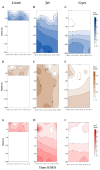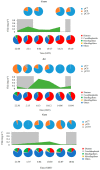Types and Distribution of Bioactive Polyunsaturated Aldehydes in a Gradient from Mesotrophic to Oligotrophic Waters in the Alborán Sea (Western Mediterranean)
- PMID: 32178402
- PMCID: PMC7143741
- DOI: 10.3390/md18030159
Types and Distribution of Bioactive Polyunsaturated Aldehydes in a Gradient from Mesotrophic to Oligotrophic Waters in the Alborán Sea (Western Mediterranean)
Abstract
Polyunsaturated aldehydes (PUAs) are bioactive molecules suggested as chemical defenses and infochemicals. In marine coastal habitats, diatoms reach high PUA production levels during bloom episodes. Two fractions of PUA can usually be analyzed: pPUA obtained via artificial breakage of collected phytoplankton cells and dissolved PUA already released to the environment (dPUA). In nature, resource supply arises as a main environmental controlling factor of PUA production. In this work, we monitored the vertical distribution and daily variation of pPUA associated with large-size phytoplankton and dPUA, at three sites located in the Alborán Sea from mesotrophic to oligotrophic waters. The results corroborate the presence of large-size PUA producers in oligotrophic and mesotrophic waters with a significant (58%-85%) diatom biomass. In addition to diatoms, significant correlations between pPUA production and dinoflagellate and silicoflagellate abundance were observed. 2E,4E/Z-Heptadienal was the most abundant aldehyde at the three sites with higher values (17.1 fg·cell-1) at the most oligotrophic site. 2E,4E/Z-Decadienal was the least abundant aldehyde, decreasing toward the oligotrophic site. For the first time, we describe the daily fluctuation of pPUA attributable to cellular physiological state and not exclusively to taxonomical composition. Our results demonstrate the persistence of threshold levels of dPUA deep in the water column, as well as the different chromatographic profiles of dPUA compared with pPUA. We propose different isomerization processes that alter the chemical structure of the released PUAs with unknown effects on their stability, biological function, and potential bioactivity.
Keywords: Alborán Sea; diatoms; oligotrophy; oxylipins; polyunsaturated aldehydes, PUA.
Conflict of interest statement
The authors declare no conflicts of interest.
Figures







Similar articles
-
Toxicity of diatom polyunsaturated aldehydes to marine bacterial isolates reveals their mode of action.Chemosphere. 2017 Jun;177:258-265. doi: 10.1016/j.chemosphere.2017.03.031. Epub 2017 Mar 9. Chemosphere. 2017. PMID: 28314230
-
Potential polyunsaturated aldehydes in the Strait of Gibraltar under two tidal regimes.Mar Drugs. 2014 Mar 13;12(3):1438-59. doi: 10.3390/md12031438. Mar Drugs. 2014. PMID: 24633248 Free PMC article.
-
Polyunsaturated aldehydes from large phytoplankton of the Atlantic Ocean surface (42°n to 33°s).Mar Drugs. 2014 Jan 27;12(2):682-99. doi: 10.3390/md12020682. Mar Drugs. 2014. PMID: 24473169 Free PMC article.
-
Toxigenic effects of diatoms on grazers, phytoplankton and other microbes: a review.Ecotoxicology. 2010 Mar;19(3):493-511. doi: 10.1007/s10646-009-0434-y. Ecotoxicology. 2010. PMID: 19924531 Review.
-
Diatom/copepod interactions in plankton: the indirect chemical defense of unicellular algae.Chembiochem. 2005 Jun;6(6):946-59. doi: 10.1002/cbic.200400348. Chembiochem. 2005. PMID: 15883976 Review.
Cited by
-
Changes of Volatile Flavor Compounds in Large Yellow Croaker (Larimichthys crocea) during Storage, as Evaluated by Headspace Gas Chromatography-Ion Mobility Spectrometry and Principal Component Analysis.Foods. 2021 Nov 25;10(12):2917. doi: 10.3390/foods10122917. Foods. 2021. PMID: 34945468 Free PMC article.
-
Widespread Production of Polyunsaturated Aldehydes by Benthic Diatoms of the North Pacific Ocean's Salish Sea.J Chem Ecol. 2024 Jun;50(5-6):290-298. doi: 10.1007/s10886-024-01496-9. Epub 2024 Apr 22. J Chem Ecol. 2024. PMID: 38644438
-
Gas-phase ion migration spectrum analysis of the volatile flavors of large yellow croaker oil after different storage periods.Curr Res Food Sci. 2022 May 8;5:813-822. doi: 10.1016/j.crfs.2022.04.012. eCollection 2022. Curr Res Food Sci. 2022. PMID: 35592694 Free PMC article.
-
Multiple Roles of Diatom-Derived Oxylipins within Marine Environments and Their Potential Biotechnological Applications.Mar Drugs. 2020 Jun 30;18(7):342. doi: 10.3390/md18070342. Mar Drugs. 2020. PMID: 32629777 Free PMC article. Review.
-
Characterization of non-volatile and volatile flavor profiles of Coregonus peled meat cooked by different methods.Food Chem X. 2023 Jan 21;17:100584. doi: 10.1016/j.fochx.2023.100584. eCollection 2023 Mar 30. Food Chem X. 2023. PMID: 36845502 Free PMC article.
References
-
- Fontana A., d’Ippolito G., Cutignano A., Miralto A., Ianora A., Romano G., Cimino G. Chemistry of oxylipin pathways in marine diatoms. Pure Appl. Chem. 2007;79:481–490. doi: 10.1351/pac200779040481. - DOI
MeSH terms
Substances
Grants and funding
LinkOut - more resources
Full Text Sources

